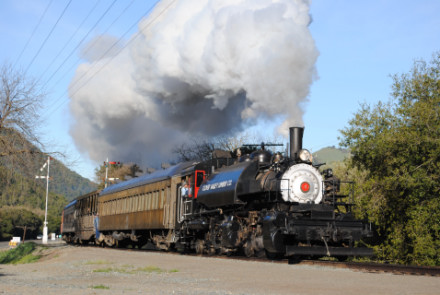

After a great Winterail, Chris Parker, Bob and Elizabeth Alkire and I checked out of the Red Roof Inn and met at the car. We took Bob Riskie to the Altamont Commuter Express station so he could catch Train 702 south. From there we drove to Tracy to a McDonald's for my usual hot cakes and sausage breakfast. We then headed drove over to Dr. Powers Park to our first stop of the morning.
Southern Pacific 0-6-0 1293 built by Lima in 1924. It worked in several Southern Pacific yards along the Pacific Lines for the next thirty-four years before being retired in 1958 and donated to the City of Tracy. We then drove across Altamont Pass to our next stop of Livermore.
The Livermore Southern Pacific station built in 1892 and now a real estate office.
The Livermore station signs.
The historic plaque. From here we drove to Sunol, parked the rental car then joined the photo line.
We waited for Clover Valley Lumber 2-6-6-2T 4 to arrive.
All the photographer's shadows.
Clover Valley Lumber Company 4This steam engine is one of 36 logging mallets built by Baldwin Locomotive Works in 1924 and is one of only two operating in the United States. It was built for the Clover Valley Lumber Company to haul logs to their sawmill in Loyalton, California. Over the next 32 seasons, the Number 4 spent the summer logging season running between the woods and the sawmill. In December 1956 the Clover Valley Lumber Company became the Feather River Lumber Company.
Number 4 operated one more season hauling before being sold to the Tahoe Timber Company at Jackpot, Nevada for a stationary boiler. The Pacific Locomotive Association acquired Number 4 and moved it from Nevada to the Castro Point Railway in Richmond, California in 1973. Number 4 was returned to operation at Castro Point in 1978 and operated there until 1985 when the locomotive, along with the rest of the PLA's steam locomotives, was moved to storage in Fremont.
In 2005, Number 4 was moved over the Union Pacific rails to Niles Canyon. The restoration of began in earnest in September 2007 with the descaling of the boiler. Over the next five years, the PLA Steam Department worked on returning the locomotive to operating condition, when not operating and maintaining PLA's other two operable steam locomotives, Robert Dollar 3 and Quincy Railroad 2. Restoration of Number 4 included boiler work including flush patches in the firebox, replacement of the lower section of the front tube sheet, inspecting all the running gear, rebuilding the fire pan, building new dampers, repairing superheaters, replacing the lower half of the smokebox, replacing all steam and water piping, fixing a leaky fuel tank, repairing the cab, replacing all windows and rebuilding the cab supports and floor.
In addition to the thousands of volunteer hours involved in the restoration, over 60 percent of the project cost was funded by PLA member donations (included in these funds was a restoration grant received from Trains Magazine). Number 4 moved under its own power for the first time in 27 years on August 25, 2012. The Pacific Locomotive Association is proud to have the Number 4 pulling its first public excursion since 1985 on today's Winterail Photographer's Special, which also coincidently falls on Clover Valley Lumber 4's 89th birthday.
The Trip
Clover Valley Lumber 2-6-6-2T 4 arrived in Sunol. We boarded the train and waited while they watered the engine.
The engine cut off the train.
The hose had to be moved before the engine could be run around the train.
Clover Valley Lumber 4 reversed by our train to the switch and once the switch was thrown, the engine would couple up to our train.
The engine started to move forward.
The engine was moving to us and will be coupling up on our train.
Marker light.
Our engineer waiting for his crew briefing.
Crew briefing and a few minutes later, we departed Sunol heading west down Niles Canyon to Niles.
The train ran by the semaphore signals.
Heading west through Niles Canyon.
The first wig wag crossing signal.
Passing the second wig wag crossing signal.
Our engineer looking forward as we head down Niles Canyon.
The marker lights on Clover Valley Lumber 4.
Headlight and builder's plate.
Western Pacific caboose 467 built by International Car in 1973.
Two views of the Niles Southern Pacific station built in 1901
Our engine cut off our train so it could run around us.
While our engine was reversing to the switch, Capitol Train 727 headed to San Jose went by us.
| Click here for Part 2 of this story |